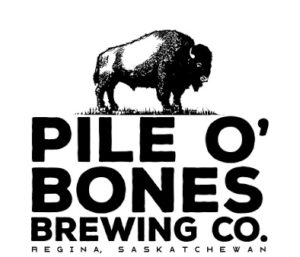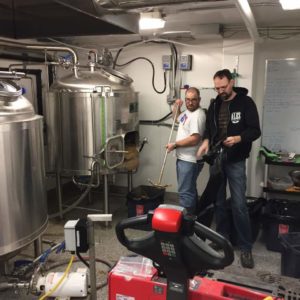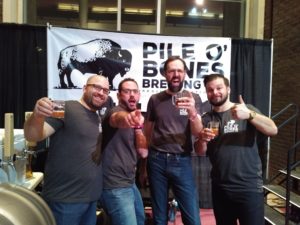 Its amazing what can happen when four avid homebrewers stumble across a commercial brewing system. About a year ago Glenn Valgardson, David Freeman, Brent Babyak and Josh Morrison, who are all longtime homebrewers and stalwarts of Regina’s Ale and Lagers Enthusiasts of Saskatchewan (ALES) – one of the country’s biggest and most successful homebrew clubs – were offered an opportunity to take over the derelict brewing system in the basement of O’Hanlon’s Pub.
Its amazing what can happen when four avid homebrewers stumble across a commercial brewing system. About a year ago Glenn Valgardson, David Freeman, Brent Babyak and Josh Morrison, who are all longtime homebrewers and stalwarts of Regina’s Ale and Lagers Enthusiasts of Saskatchewan (ALES) – one of the country’s biggest and most successful homebrew clubs – were offered an opportunity to take over the derelict brewing system in the basement of O’Hanlon’s Pub.
O’Hanlon’s is a longtime, popular downtown Regina pub that has long offered Saskatchewan beer as part of its diverse beer line-up. About a decade ago they made a short-lived attempt to become a brewpub. They installed a 7-barrel brewhouse in the basement of the pub and tried to make beer. Unfortunately it was a day early and a dollar short. “They found out it was difficult to operate a brewery in the Regina market, especially if you didn’t use real brewers,” says Freeman. O’Hanlon’s cut their losses and shuttered the brewery. It has sat dormant for years.
But the four partners jumped at the opportunity to revitalize it, even if it was not the ideal space. You see, it is located in the basement of O’Hanlon’s, basically in “a storage room of the parkade garage underneath the pub,” notes Valgardson. They spent the last year renovating and upgrading the space and equipment to make it suitable for a production brewery – including an insane amount of cleaning and sanitizing the derelict equipment. Still, it remains an unusual system. “It is Saskatchewan’s only electric-fired brewhouse. We also have three dish-bottom fermenters,” says Freeman. Dish-bottom fermenters have a flatter bottom than conicals, which can change a number of factors in the brewing process.
They have called their burgeoning operation Pile O’ Bones Brewing. They have had beer on the market since mid-December and they are slowly ramping up production. At the moment they are keg-only, given their space constraints, but do have some bigger plans for the future.
Their vision for the beer sticks close to their homebrewing roots. “We aim to create classically styled craft beer that is executed well,” says Babyak. “We are about malt and hops. Not saying we won’t use experimental adjuncts, but that is not what we are about. We are not worried about throwing a bunch of spices in. We want to produce traditional beer. None of us are afraid to do things the hard way.”
They are also trying to carve their own niche in Regina’s beer scene. “We looked at the market and tried to see where the holes are” says Freeman. They don’t see local operations like Bushwakker and Rebellion as competitors, and so want to find a way to co-exist alongside them.
As for the beer themselves, for now they have landed on four beer to focus on, with seasonals coming in the future. Their core line-up includes: a Red IPA, “hoppy but not too light or too dark”; a White IPA, “we wanted something that the occasional beer drinker would like as well as craft drinkers”; a Chocolate Stout, “a darker beer but we didn’t want it to be too roasty or have too much coffee”; and their most recent, a Pale Ale, which is “something approachable for the average beer drinker”.
They have also just released their first attempt at a Blonde Ale. They are not sure if it will join the others as a regular offering and are waiting on customer reaction to decide.
As mentioned, the plan is once the core beer are established (and they buy more fermenters), they will release various seasonals and one-offs. The immediate plan is to offer keg only, but in the longer term they hope to upgrade to a packaging line of some sort. One of their hopes is to have the space to age some unique beer that they can sell in bottles as a special offering.
In addition to being homebrewers, the four bring other valuable skills to operating a brewery. Valgardson is a certified mechanic, Morrison is a lawyer, Freeman is involved in communications and market research, and Babyak is in IT. Not a bad combination of skills for opening a brewery. For the moment they are all keeping their day jobs, plus some of them have young families. “We are being weekend and night-time warriors,” says Valgardson.
As for the name, most locals understand the reference. It is connected to the original name for Regina. It was a good hunting ground for Indigenous hunters. They developed the practice of leaving piles of buffalo bones behind with the thought that the remaining buffalo would come back to visit the bones. As a result, original European settlers called the area Pile of Bones. The name Regina came after when they formally incorporated the town.
“We picked the name because we wanted to pay homage to the history of Regina and the place we come from,” says Freeman. “We wanted to make sure when a customer saw the logo and the name they knew we were from Regina and not some random craft brewery. We want them to know it was beer made right here in Regina.”
The group is a bit vague on their long term plans – they are focused right now on just getting up and running, but they envision an operation that supports them all full-time and produces beer that can be sold across the province. Whether that is in their current space or they open a new brewery elsewhere is still an open question.
But for now Regina beer drinkers can pile on in their support for Pile O’ Bones Brewing.
[edited Mar 1/17 to fix a couple minor details.]




February 11, 2017 at 4:57 PM
Love the name, Pile of Bones. Reminds me of Head Smashed in Buffalo Jump and the paddocks east of Edmonton. They finally brought back some Buffalo to Banff National Park and if you have ever tried to coral a herd of Buffalo you’ll know why they used helicopters to get them there. That alone deserves a six pack and will be trying a Pile of Bones soon. Thanks